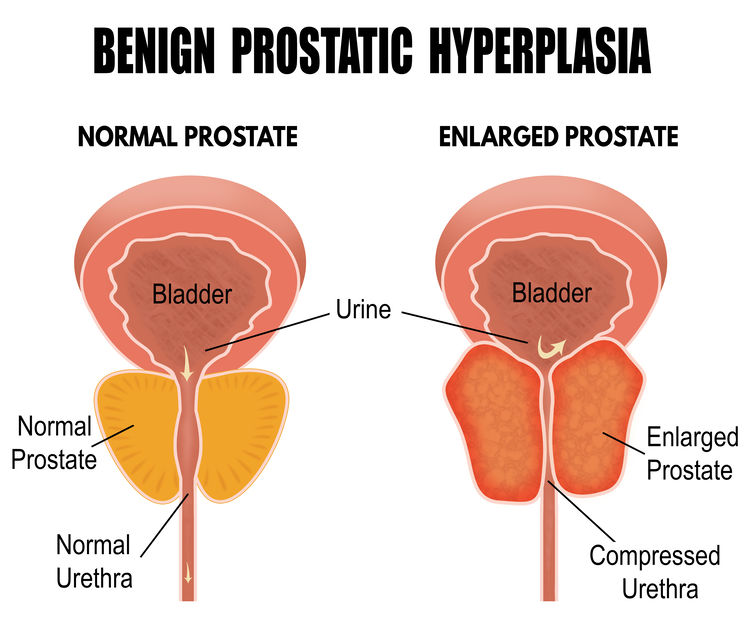Benign Prostatic Hyperplasia / Urology
Enlarged Prostate: Which is the best treatment option?

by admin
7th October 2019
6 minutes read
After you are diagnosed with Benign Prostatic Hyperplasia (Enlarged Prostate), you might be looking for treatment options for the enlarged prostate. If so, then you have wide options to choose from. Benign Prostatic Hyperplasia Treatment options will depend on multiple factors, some of the major factors are
- Your Prostate size
- Age
- Your health
- How much are the symptoms causing discomfort for you

Benign prostatic hyperplasia, vector illustration (for basic medical education, for clinics & Schools)
It is advisable to consult doctor to get treatment for an enlarged prostate. Depending on the stage or symptoms of BPH, doctor might suggest one of the following:
- Lifestyle changes and wait and see approach
- Medical Management of BPH (Medical Treatment)
- Surgical Management of BPH (Surgical Treatment)
Lifestyle changes and wait & see approach
If the symptoms are not predominant then the doctor might suggest self-care. The doctor might postpone the treatment till he/she thinks it is appropriate. This is because, in some cases, symptoms can ease without treatment.
Meanwhile, the doctor might ask you to make simple lifestyle changes. These include timed urination and decrease in the consumption of alcohol and caffeine.
When the doctor things it is appropriate, he/she might suggest medical or surgical treatment options.
Also Read : Kidney Stones
Medical Management of BPH
The doctor might opt for enlarged prostate or BPH medications for the followings reasons:
- Your symptoms are moderate and they are getting worse instead of getting better.
- Adoption of lifestyle changes didn’t show any results.
- Your BPH might be causing complications.
The doctor might suggest one of the following categories of BPH Drugs to treat your symptoms. It is advisable to take these drugs only if your doctor prescribes you to take them.
-
Doctors use Alpha Blockers to relax muscles of the bladder neck muscles and prostate muscles, so that the patient can urinate with ease.
-
5-alpha reductase inhibitors (5-ARIs) prevent hormonal changes which cause prostate growth. Therefore, they effectively prevent the growth of prostate. 5-ARIs also help to shrink the prostate.
-
It is observed that Phosphodiesterase 5 inhibitors (PDE5 inhibitors) that are often used to treat erectile dysfunction, improve Benign Prostatic Hyperplasia symptoms and increase flow rate. Therefore, they are sometimes used to treat Prostate Enlargement.
*Consumption of medications at the advice of doctor only.
Combination Drug Therapy
When neither Alpha Blockers nor 5-ARIs are effective, doctors might suggest you to take both Alpha Blockers and 5-ARIs at the same time. This method of treatment, where men with BPH take more than one medication is called Combination Drug Therapy. It reduces the need for surgery but there is a risk that men taking both drugs may start to experience side effects of both drugs.
*Consumption of medications at the advice of doctor only.
Hormone Reduction Medications
Sometimes, the doctor might prescribes medications that reduce the levels of hormones produced by prostate gland. These medications may make the prostate smaller and improve urine flow. They also lower the levels of testosterone as a result they may cause side effects like decreased sex drive and impotence.
Antibiotics
Chronic Bacterial Prostatitis is a condition where the prostate gets infected, as a result, you can see swelling, inflammation and frequent Urinary Tract Infections (UTIs). In such situation, doctor uses Antibiotics to improve the symptoms of BPH by reducing the inflammation.
Surgical Management of BPH
If the symptoms persist even after the medical treatment of BPH, then doctors might opt for surgical intervention. There are multiple minimally invasive and surgical therapies that you can choose from, they are:
1. Prostate Artery Embolization
Prostatic Artery Embolization (PAE) is a latest minimally invasive treatment for BPH. PAE is a procedure where the surgeon selectively embolisms the prostatic artery with embolic agents. This blocks the blood supply to the prostate. As a result, the prostate shrinks relieving the patient of symptoms.
PAE is a daycare procedure which means the patient can go home on the same day. Blood loss during surgery and Post-surgical pain is minimal. PAE has minimal recovery time, minimal risks and high success rate.
Due to its advantages and minimal risks, PAE is becoming an attractive treatment option for men who are suffering from BPH. Consult an expert doctor to know whether PAE is a suitable treatment option for you.
2. Transurethral Resection of the Prostate (TURP)
Transurethral Resection of the prostate (TURP) is a surgical procedure where the the surgeon removes the excess prostate tissue which is blocking the urine flow. After the TURP surgery, the patient will quick relief from the symptoms. The surgeon might place catheter to drain your bladder after the surgery which will be removed after couple of days.
3. Transurethral Incision of the Prostate (TUIP)
Unlike in TURP, In TUIP, There is no removal of tissue. In TUIP, the surgeon inserts a combined visual and surgical instrument (Resectoscope) into urethra through penis. Then the surgeon makes one or two small grooves in the bladder neck area (the area where prostate connects to bladder). This relaxes the opening to the bladder hence allowing for urine to pass more easily.
4. Holmium Laser Enucleation of the Prostate (HoLEP)
HoLEP is a minimally invasive treatment for an Enlarged Prostate. HoLEP can be used effectively to treat even the largest of prostate glands. In HoLEP the surgeon uses LASER to remove all the prostate tissues that are blocking urine flow. Then the surgeon uses another instrument to cut the prostate into smaller removable fragments.
Other Minimally Invasive Surgical Options
Other surgical options like Transurethral Microwave Thermotherapy (TUMT), (Transurethral Needle Ablation) TUNA and Ablative Process uses microwave energy, radio waves and high energy laser respectively to remove prostate tissue to increase urine flow and provide relief from symptoms. Another procedure called Prostatic Urethral Lift (PUL) is used to increase the flow of urine by using tags to compress the sides of prostate.
Open Surgery – Prostatectomy
Prostatectomy is a surgical procedure where the surgeon removes a part or all of prostate. There are two types of prostatectomy, they are simple prostatectomy and radical prostatectomy. Surgeon usually performs Simple Prostectomy to treat benign conditions like BPH where the surgeon removes a part of the prostate. Where as in Radical Prostectomy the surgeon removes entire prostate gland along with vas deferens and seminal vesicles. Surgeons perform Radical Prostectomy to treat malignant cancer.
We have covered here all treatment options for BPH. Consult your doctor to know which is the most suitable treatment option for you.
You can watch videos to know more about BPH and its Treatment Options by visiting our youtube channel.
CATEGORIES
- ACL Reconstruction
- Anal Fissures
- Anal Fistula
- Appendicitis
- ASK A DOCTOR
- Benign Prostatic Hyperplasia
- Breast Lump Excision
- Cataract
- Circumcision
- Conditions & Diseases
- Cosmetology
- Covid-19
- Cure
- Endocrinology
- ENGLISH VIDEOS
- Eye Care
- Gallstones
- General Surgeries
- Government Schemes
- Gynaecology
- Gynecomastia
- Gynecomastia
- Health
- Health Insurance
- Hernia
- hindi
- Hip Arthoscopy
- Hip Replacement
- Hip Replacement Surgery
- Hydrocele
- Kannada
- Kidney Stones
- Knee Arthroscopic
- Laparoscopic
- LASER
- Latest Treatments
- Lifestyle
- Liposuction
- Medfin Stories
- Medicine
- Nephrology
- Ophthalmology
- Orthopaedic
- Paraphimosis
- Patient Testimonials
- PCL Reconstruction
- Phimosis
- Piles (Hemorrhoids)
- Pilonidal Sinus
- Proctology
- Prostate Artery Embolization
- Rhinoplasty
- Second Opinion
- Total Knee Replacement
- Uncategorised
- Urology
- uterine artery embolization
- Uterine Fibroids
- Varicocele
- Varicose Veins
- Vascular
- VIDEOS






